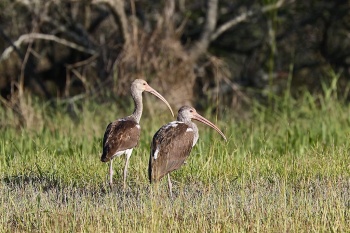Alternative name: American White Ibis to distinguish it from the Australian White Ibis.
- Eudocimus albus
Identification
56–71 cm (22-27¾) long; 95 cm wingspan
- All-white plumage
- Black wingtips (visible in flight)
- Reddish bills (extending into the face on breeding birds)
- Reddish legs
- Non-breeding birds show a pink to red face
Juveniles are largely brown with duller bare parts
Similar Species
Juveniles differ from the Glossy and White-faced Ibises by white underparts and rumps.
Distribution
Southern United States south through Central America and the Greater Antilles to northwestern South America.
Taxonomy
This bird hybridizes with the Scarlet Ibis, and they are sometimes considered conspecific.
Subspecies
Two subspecies are recognized[1].
- E. a. albus - coastal and lowlands areas of western Mexico and the southeastern United States south to Costa Rica and east to the Greater Antilles.
- E. a. ramobustorum - Panama and northern South America: Pacific coast from Colombia south to extreme northwestern Peru (Tumbes); coastal northern Colombia and northern Venezuela; and llanos of eastern Colombia and western Venezuela.
Habitat
Their favoured habitat is marshy wetlands and coastal pools. They also occur on mowed grass and have become common in some city parks.
Behaviour
Action
In flight the neck and legs are outstretched and are often seen in long, loose lines.
Breeding
Monogomous and colonial, usually nesting in mixed colonies with other wading species.
They builds a stick nest in trees, bushes, or over water. The clutch consists of 2 to 5 eggs.
Diet
They use the long, curved bill to probe in mud for a variety of fish, frogs and insects.
Vocalisation
Call: the male advertises his presence with a hunk-hunk-hunk-hunk. The female squeals.
The birds often give a soft, grunting croo, croo, croo when foraging.
Gallery
Click on photo for larger image
References
- Clements, J. F., T. S. Schulenberg, M. J. Iliff, S. M. Billerman, T. A. Fredericks, J. A. Gerbracht, D. Lepage, B. L. Sullivan, and C. L. Wood. 2021. The eBird/Clements checklist of Birds of the World: v2021. Downloaded from https://www.birds.cornell.edu/clementschecklist/download/
- Keith Bildstein, White Ibis: Wetland Wanderer (Smithsonian: 1993), ISBN 1560982233
- Heath, J. A., P. C. Frederick, J. A. Kushlan, and K. L. Bildstein (2020). White Ibis (Eudocimus albus), version 1.0. In Birds of the World (A. F. Poole, Editor). Cornell Lab of Ornithology, Ithaca, NY, USA. https://doi.org/10.2173/bow.whiibi.01
- Wikipedia
Recommended Citation
- BirdForum Opus contributors. (2025) White Ibis. In: BirdForum, the forum for wild birds and birding. Retrieved 27 April 2025 from https://www.birdforum.net/opus/White_Ibis
External Links
GSearch checked for 2020 platform.1










